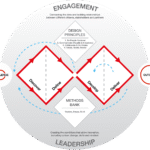
Can you imagine a classroom where technology is not just a tool but an engine for learning? A space where creativity and problem-solving are at the core of education? Innovative Educational Projects are the key that opens the doors to this future and paves the way toward Education 4.0.
Innovative Educational Projects have become a crucial tool for enhancing teaching and learning processes; as the implementation of this approach turns the student into an active participant.
In this article, we will delve deep into the universe of Innovative Educational Projects. We will define what these projects are, their characteristics, inspiring examples, and why they are so important for the future of education.
What are Innovative Educational Projects?
The International University of La Rioja (UNIR) reports that Innovative Educational Projects, or educational innovation projects. “is characterized by addressing the needs or problems of an educational institution from a different perspective through new and creative activities that foster learning originally.”
Educational innovation projects are initiatives that seek to transform teaching and learning by implementing new strategies, methodologies, and tools. They are characterized by the following:
- Creative: They seek original solutions to the educational needs of the present.
- Student-centered: They promote active and participative learning.
- Technological: They integrate information and communication technologies (ICT) in a meaningful way.
- Collaborative: They involve the educational community in their design and implementation.
Through the use of educational innovation projects, you can address a wide range of educational challenges, from the lack of student motivation to the need for greater inclusion in the classroom. In this regard, Lamscheck (2023) emphasizes that this type of project focuses on the expected impact on students and, therefore, on the competencies of teachers, trainers, administrators, and the support of the surrounding systems.
Importance of educational innovation projects
In a constantly changing world, education cannot be left behind. Educational innovation projects are essential to:
- Adapt to the needs of 21st-century students: Today’s students are digital natives and have different learning styles than previous generations. Educational innovation projects can help educators connect with these students and provide them with a more relevant and engaging education.
- Improve learning outcomes: Evidence shows that educational innovation projects can have a positive impact on student academic achievement.
- Develop 21st-century skills: Educational innovation projects can help students develop essential skills for success in the 21st century, such as creativity, problem-solving, teamwork, and communication.
- Foster innovation in schools: Educational innovation projects can create a culture of innovation in schools, where educators and students are motivated to experiment and try new ideas.
Santaolalla et al., (2020) report that there is statistically significant evidence that educational innovation projects have a positive impact on children, with significant improvements in the learning of Mathematics and Social Sciences.
Areas for educational innovation
In which areas can we innovate?
Researcher Barraza (2013) describes the areas where educational innovation can be developed:
a) Institutional innovation
- Policies: negotiation of conflicts and decision making.
- Administrative: planning, direction, organization, communication and evaluation.
b) Curricular innovation
- Diagnosis: definition of models and construction of information collection strategies.
- Curriculum structuring: definition of models and approaches.
- Curriculum evaluation: definition of models and construction of information collection strategies.
c) Didactic innovation
- Didactic planning: preparation of records, construction of models and definition of processes.
- Didactic intervention: construction of didactic strategies and means for teaching.
- Assessment of learning: design of instruments and construction of strategies.
How to innovate in education?
Currently, the Technological Pedagogical Content Knowledge (TPACK) model and the “Flipping the Classroom” concept have gained popularity to promote innovation in educational practices.
TPACK model
The Technological Pedagogical Content Knowledge (TPACK) model is based on the approach of allowing teachers to identify the knowledge they need to improve the teaching-learning process through technological applications. In this way, the teacher must understand that there is no single way to use technology in the classroom.
TPACK is based on three primary knowledge areas: pedagogical, content, and technological; combining them, seven specific knowledge are obtained:
- Content knowledge (CK)
- Pedagogical knowledge (PK)
- Technological Knowledge (TK)
- Pedagogical content knowledge (PCK)
- Technological content knowledge (TCK)
- Technological-pedagogical knowledge (TPK)
- Techno-Pedagogical Knowledge of Content (TPACK)
According to Salas (2019), the use of the TPACK model allows teachers to identify the aspects that influence the development of educational practice, the understanding of the factors on learning and the creation of school activities through digital tools.
More information about TPACK at: http://tpack.org/
Flipped Classroom
Several researchers highlight that the Flipped Classroom model, also known as the inverted classroom, is a teaching method that is based on learning by doing and not memorizing. In this way, students become an active part of the teaching-learning processes.
The flipped classroom promotes that students study and prepare lessons outside of class, relying on new technologies, the teacher acts as a guide.
Researcher Brame (2013) emphasizes that in essence, Flipped classroom allows students to have their first exposure to new material (readings or videos) outside of class, and then use class time to assimilate knowledge, through problem-solving, discussion, or debates.
Among the advantages of flipped classroom are:
- Students are the protagonists
- Consolidates knowledge
- Promotes diversity in the classroom
- Deeper and more lasting learning over time
- Improves the development of skills through individual and collaborative work
- Greater motivation in the student
More information about Flipped Classroom (FC): https://www.theflippedclassroom.es/
Tools for educational innovation
Beyond formulating a project, you need to know the tools available to become an innovative teacher.
What tools are available to promote educational innovation? Here are three of the most important tools for educational innovation:
Design Thinking
Design Thinking can be applied in the classroom to solve problems or address challenges, offering solutions that respond to the needs of society.
“Design thinking is basically a human-centered and oriented process that believes in the value and experiences of users,” says Adams (2017). Recently, Butler et al., (2023) demonstrated the usefulness of design thinking to drastically increase the creative self-efficacy and problem-solving skills of high school students, attitudes about teamwork, and the tendency to seek feedback.
The stages of design thinking adapted to the educational process are:
- Empathize: Define the challenge and create a project.
- Define and interpret: Share what you have investigated as if it were a story, turn problems into opportunities through idea-generating questions.
- Ideate: Unleash your imagination and creativity to generate solution proposals.
- Prototype and experiment: Build prototypes and identify aspects that need to be improved.
- Test and improve the idea: Define success and document progress.
If you are interested in learning more about Design Thinking for educators, you can download IDEO’s toolkit here.
Co-creation
Co-creation is a work methodology in which the users of a design are considered “partners in its creation” (Anquela, 2018). In other words, it is the users who can express their needs.
According to Mollie et al. (2018), the value co-creation process allows institutions and students to work together to improve the student experience and increase the capacity to act as partners.
Anquela (2018) emphasizes that co-creation is something that can be closely related to collective intelligence, which is defined as the intelligence that arises from the collaboration of many individuals.
Project-Based Learning (PBL)
Project-based learning is a methodology that is developed collaboratively and confronts students with situations that lead them to propose solutions to specific problems, as defined by Cobo and Valdivia (2017).
PBL is student-centered and revolves around student-driven research of a problem. The project requires teamwork between students and concludes with a significant final product.
According to Toledo and Sánchez (2018), the project-based learning methodology requires students to be active and responsible for their own learning. The implementation of a project, according to Cobo and Valdivia (2017), can be carried out in the following stages:
- Project planning and organization
- Research on the topic
- Definition of objectives and work plan
- Implementation
- Presentation and evaluation of results
Finally, Rees et al., (2019) emphasize that to promote the adoption of PBL, educational technology innovators could communicate existing technology or create technological innovations that provide: (a) outreach tools for sourcing and team-building projects; (b) authoring tools for sharing and remixing curricular materials; (c) project management tools for managing and tracking teams; and (d) coordination software to manage all stakeholders.
Examples of Innovative Educational Projects
- Flipped classrooms: In a flipped classroom, students learn new concepts at home through videos, readings, or other online resources. In class, they work on practical and collaborative activities to apply what they have learned. Rodríguez-Carmona and Herrero (2018) present two flipped classroom methodology projects; in them, the student was proposed to carry out prior training to the sessions with the teacher.
- Project-based learning: Project-based learning allows students to learn through research and real-world problem-solving. Syakur et al., (2020) used project-based learning to promote English language learning and demonstrated improved student learning.
- Gamification: Gamification uses game elements to motivate students and make learning more fun. López et al., (2023) report that gamification improves student motivation and skills.
- Virtual and augmented reality: Virtual and augmented reality can provide students with immersive and memorable learning experiences. Audiffred et al., (2022) report the use of virtual reality glasses to study Human Anatomy using different 3D Virtual Reality applications; even though they did not find significant differences in learning, its use as a learning tool is important.
Designing educational innovation projects
To create successful Innovative Educational Projects, it is essential to follow a clear methodology that can be based on:
- Identifying the educational need or problem to be solved.
- Researching and analyzing possible solutions.
- Designing the project creatively and innovatively.
- Implementing the project with the participation of the educational community.
- Evaluating the results and making necessary improvements.
Within the framework of Education 4.0, Miranda et al., (2021) highlights four central components that will serve as a reference for the design of new Innovative Educational Projects:
- Competencies
- Learning Methods
- Information and Communication Technologies
- Infrastructure
Resources for designing Innovative Educational Projects
You can find a number of resources on the internet that can inspire and guide you in the formulation of educational innovation projects. Here are some:
- Edutopia: Edutopia is a non-profit organization that offers resources and ideas on educational innovation, effective teaching practices, and professional development for educators.
- International Society for Technology in Education (ISTE): ISTE provides standards for the effective integration of technology in education and resources for education professionals.
- Project-Based Learning: PBLWorks is an organization that focuses on project-based learning (PBL). They offer resources, curriculum, and training for educators interested in implementing PBL.
- Khan Academy: Khan Academy offers a variety of free online educational resources. It can be a valuable source for inspiring innovative educational practices.
- Common Sense Education: This organization provides resources for educators on digital literacy, digital citizenship, and the responsible use of technology in the classroom.
- Kahoot!: Platform for creating interactive educational games.
Remember to adapt these resources to your specific needs and the characteristics of your educational environment.
Conclusions
Current teaching and learning practices need to be innovated to ensure that students develop their creativity and learn. Remember that educational innovation is an ongoing process and that we can all contribute to its development.
In this article, we have provided you with some general concepts and tools that can guide you to become an innovative teacher by implementing educational innovation projects.
Innovative Educational Projects are a powerful tool for transforming teaching and learning. If you are looking for ways to improve education in your community, we invite you to explore the world of educational innovation and to participate in projects that make a difference.
You can also access the links to the educational innovation training videos of the Innovative Teaching Across Continents (InnovaT) project in the following document (page 7).
Finally, we invite you to explore the exciting world of educational innovation. Investigate, participate, design, and share your ideas. The future of education is in our hands, and educational innovation projects are an important tool.
If you have found this information useful, please do not hesitate to share it with your friends, colleagues, etc.
References
Adams J. 2017. El pensamiento de diseño en la educación. International Baccalaureate Organization (IBO).
Anquela R. 2018. Cómo fomentar la cocreación en el aula. Red Social Educativa.
Audiffred_hinojosa, A., Pantoja_bedolla, F. P., & Miranda_Leal, S. (2022, October). Research is formalized curiosity: Use of technology in the classroom is that enough virtual reality project. In Proceedings of the 14th International Conference on Education Technology and Computers (pp. 139-143).
Butler Allison G. , Heather P. Lacey, Michael A. Roberto, Deborah Hanney & Nina Luiggi (2023) Innovation Nation: Teaching middle school students to be design thinkers, Middle School Journal, 54:3, 17-28, DOI: 10.1080/00940771.2023.2185436
Cobo G. y S. Valdivia. 2017. Aprendizaje basado en proyectos. Instituto de Docencia Universitaria. PUCP. 16 p.
Barraza A. 2013. ¿Cómo elaborar proyectos de innovación educativa? Universidad Pedagógica de Durango. 96 p.
Brame, C. (2013). Flipping the classroom. Vanderbilt University Center for Teaching.
Lamscheck-Nielsen, R. (2023). RESILIENCE FOR INNOVATION PROJECTS IN THE EDUCATION SECTOR. In EDULEARN23 Proceedings (pp. 6460-6469). IATED.
López Carrillo, D., Calonge García, A., Rodríguez Laguna, T., Ros Magán, G., & Lebrón Moreno, J. A. (2019). Using Gamification in a Teaching Innovation Project at the University of Alcalá: A New Approach to Experimental Science Practices. Electronic Journal of E-learning, 17(2), 93-106.
Miranda J., C. Navarrete, J. Noguez, J.M. Molina-Espinosa, M.S. Ramírez-Montoya, S.A. Navarro-Tuch, M.R. Bustamante-Bello, J.B. Rosas-Fernández, A. Molina. The core components of education 4.0 in higher education: three case studies in engineering education, Comput. Electr. Eng., 93 (2021), Article 107278,
Mollie Dollinger, Jason Lodge & Hamish Coates (2018) Co-creation in highereducation: towards a conceptual model, Journal of Marketing for Higher Education, 28:2, 210-231
Rees Lewis, D.G., Gerber, E.M., Carlson, S.E. et al. Opportunities for educational innovations in authentic project-based learning: understanding instructor perceived challenges to design for adoption. Education Tech Research Dev 67, 953–982 (2019). https://doi.org/10.1007/s11423-019-09673-4
Rodríguez-Carmona, L. M., & Herrero, Á. P. (2018). La metodología flipped classroom en educación superior. Resultados de uso de LYNDA como recurso para las pre-clases/Application of LYNDA as a teaching resource in the project of educational innovation in the excellence of teaching. Revista de la SEECI, (46), 77-92.
Salas R. 2019. Modelo TPACK: ¿Medio para innovar el proceso educativo considerando la ciencia de datos y el aprendizaje automático? Entreciencias: Diálogos en la Sociedad del Conocimiento, vol. 7, núm. 19. DOI: https://doi.org/10.22201/enesl.20078064e.2018.19.67511
Santaolalla, Elsa, Belén Urosa, Olga Martín, Ana Verde, and Tamara Díaz. 2020. “Interdisciplinarity in Teacher Education: Evaluation of the Effectiveness of an Educational Innovation Project” Sustainability 12, no. 17: 6748. https://doi.org/10.3390/su12176748
Syakur, A., Musyarofah, L., Sulistiyaningsih, S., & Wike, W. (2020). The effect of project-based learning (PjBL) continuing learning innovation on learning outcomes of english in higher education. Budapest International Research and Critics in Linguistics and Education (BirLE) Journal, 3(1), 625-630.
Toledo P. y J. Sánchez. 2018. Aprendizaje Basado en Proyectos: Una Experiencia Universitaria. Profesorado, Vol. 22, No 2.
UNIR. 2020. La metodología TPACK: en qué consiste este modelo y cuáles son sus ventajas.
Editor and founder of “Innovar o Morir” (‘Innovate or Die’). Milthon holds a Master’s degree in Science and Innovation Management from the Polytechnic University of Valencia, with postgraduate diplomas in Business Innovation (UPV) and Market-Oriented Innovation Management (UPCH-Universitat Leipzig). He has practical experience in innovation management, having led the Fisheries Innovation Unit of the National Program for Innovation in Fisheries and Aquaculture (PNIPA) and worked as a consultant on open innovation diagnostics and technology watch. He firmly believes in the power of innovation and creativity as drivers of change and development.





